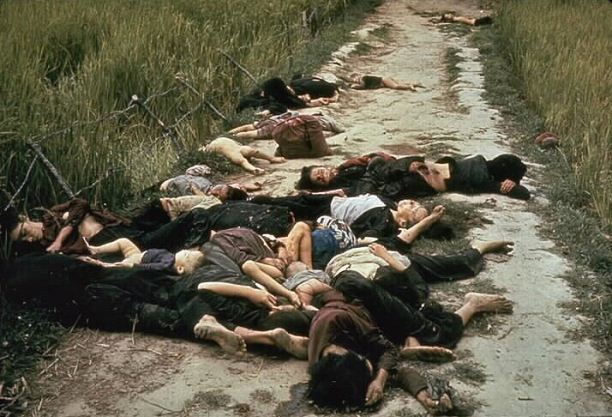March 16, 1968: My Lai Massacre Takes Place in Vietnam
HISTORY, 20 Mar 2017
History – TRANSCEND Media Service
On this day in 1968, a platoon of American soldiers brutally kills between 200 and 500 unarmed civilians at My Lai, one of a cluster of small villages located near the northern coast of South Vietnam.
During the Vietnam War, U.S. troops frequently bombed and shelled the province of Quang Ngai, believing it to be a stronghold for forces of the National Front for the Liberation of Vietnam, or Viet Cong (VC).
In March 1968, a platoon of soldiers called Charlie Company received word that Viet Cong guerrillas had taken cover in the Quang Ngai village of Son My. Led by Lieutenant William L. Calley, the platoon entered one of the village’s four hamlets, My Lai 4, on a search-and-destroy mission on the morning of March 16. Instead of guerrilla fighters, they found unarmed villagers, most of them women, children and old men.
The soldiers had been advised before the attack by army command that all who were found in My Lai could be considered VC or active VC sympathizers, and told to destroy the village. Still, they acted with extraordinary brutality, raping and torturing villagers before killing them and dragging dozens of people, including young children and babies, into a ditch and executing them with automatic weapons. The massacre reportedly ended when an Army helicopter pilot, Warrant Officer Hugh Thompson, landed his aircraft between the soldiers and the retreating villagers and threatened to open fire if they continued their attacks.
The events at My Lai were covered up by high-ranking army officers until the following March, when one soldier, Ron Ridenhour, heard of the incident secondhand and wrote about it in a letter to President Richard Nixon, the Pentagon, the State Department, the Joint Chiefs of Staff and various congressmen.
The letter was largely ignored until later that year, when investigative journalist Seymour Hersh interviewed Calley and broke the story. Soon, My Lai was front-page news and an international scandal.
In March 1970, an official U.S. Army inquiry board charged 14 officers, including Calley and his company commander, Captain Ernest Medina, of crimes relating to My Lai. Of that number, only Calley was convicted. Found guilty of personally killing 22 people, he was sentenced to life imprisonment. Upon appeal, his sentence was reduced to 20 years, and eventually to 10. Seen by many as a scapegoat, Calley was paroled in 1974 after serving just one-third of his sentence.
DISCLAIMER: The statements, views and opinions expressed in pieces republished here are solely those of the authors and do not necessarily represent those of TMS. In accordance with title 17 U.S.C. section 107, this material is distributed without profit to those who have expressed a prior interest in receiving the included information for research and educational purposes. TMS has no affiliation whatsoever with the originator of this article nor is TMS endorsed or sponsored by the originator. “GO TO ORIGINAL” links are provided as a convenience to our readers and allow for verification of authenticity. However, as originating pages are often updated by their originating host sites, the versions posted may not match the versions our readers view when clicking the “GO TO ORIGINAL” links. This site contains copyrighted material the use of which has not always been specifically authorized by the copyright owner. We are making such material available in our efforts to advance understanding of environmental, political, human rights, economic, democracy, scientific, and social justice issues, etc. We believe this constitutes a ‘fair use’ of any such copyrighted material as provided for in section 107 of the US Copyright Law. In accordance with Title 17 U.S.C. Section 107, the material on this site is distributed without profit to those who have expressed a prior interest in receiving the included information for research and educational purposes. For more information go to: http://www.law.cornell.edu/uscode/17/107.shtml. If you wish to use copyrighted material from this site for purposes of your own that go beyond ‘fair use’, you must obtain permission from the copyright owner.
